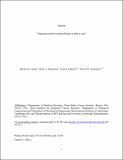| dc.contributor.author | Luskin, Marlise R. | |
| dc.contributor.author | Murakami, Mark A. | |
| dc.contributor.author | Weinstock, David M. | |
| dc.contributor.author | Manalis, Scott R | |
| dc.date.accessioned | 2018-11-06T15:18:56Z | |
| dc.date.available | 2018-11-06T15:18:56Z | |
| dc.date.issued | 2018-01 | |
| dc.identifier.issn | 1474-175X | |
| dc.identifier.issn | 1474-1768 | |
| dc.identifier.uri | http://hdl.handle.net/1721.1/118912 | |
| dc.description.abstract | Therapeutics that block kinases, transcriptional modifiers, immune checkpoints and other biological vulnerabilities are transforming cancer treatment. As a result, many patients achieve dramatic responses, including complete radiographical or pathological remission, yet retain minimal residual disease (MRD), which results in relapse. New functional approaches can characterize clonal heterogeneity and predict therapeutic sensitivity of MRD at a single-cell level. Preliminary evidence suggests that iterative detection, profiling and targeting of MRD would meaningfully improve outcomes and may even lead to cure. | en_US |
| dc.description.sponsorship | Koch Institute-Dana-Farber/Harvard Cancer Center Bridge Project | en_US |
| dc.description.sponsorship | National Cancer Institute (U.S.) (R33 CA191143) | en_US |
| dc.description.sponsorship | National Cancer Institute (U.S.). Cancer Systems Biology Consortium (U54 CA217377) | en_US |
| dc.language.iso | en_US | |
| dc.publisher | Nature Publishing Group | en_US |
| dc.relation.isversionof | https://doi.org/10.1038/nrc.2017.125 | en_US |
| dc.rights | Creative Commons Attribution-Noncommercial-Share Alike | en_US |
| dc.rights.uri | http://creativecommons.org/licenses/by-nc-sa/4.0/ | en_US |
| dc.source | Prof. Manalis via Howard Silver | en_US |
| dc.title | Targeting minimal residual disease: a path to cure? | en_US |
| dc.type | Article | en_US |
| dc.identifier.citation | Luskin, Marlise R., Mark A. Murakami, Scott R. Manalis, and David M. Weinstock. “Targeting Minimal Residual Disease: a Path to Cure?” Nature Reviews Cancer 18, no. 4 (January 29, 2018): 255–263. doi:10.1038/nrc.2017.125. | en_US |
| dc.contributor.department | Massachusetts Institute of Technology. Department of Biological Engineering | en_US |
| dc.contributor.department | Massachusetts Institute of Technology. Department of Mechanical Engineering | en_US |
| dc.contributor.department | Program in Media Arts and Sciences (Massachusetts Institute of Technology) | en_US |
| dc.contributor.approver | Manalis, Scott R | en_US |
| dc.contributor.mitauthor | Manalis, Scott R | |
| dc.relation.journal | Nature Reviews Cancer | en_US |
| dc.eprint.version | Author's final manuscript | en_US |
| dc.type.uri | http://purl.org/eprint/type/JournalArticle | en_US |
| eprint.status | http://purl.org/eprint/status/PeerReviewed | en_US |
| dspace.orderedauthors | Luskin, Marlise R.; Murakami, Mark A.; Manalis, Scott R.; Weinstock, David M. | en_US |
| dspace.embargo.terms | N | en_US |
| dc.identifier.orcid | https://orcid.org/0000-0001-5223-9433 | |
| mit.license | OPEN_ACCESS_POLICY | en_US |
